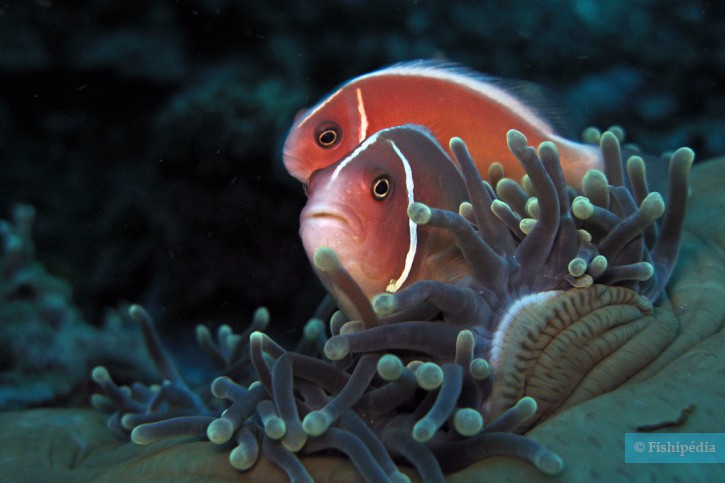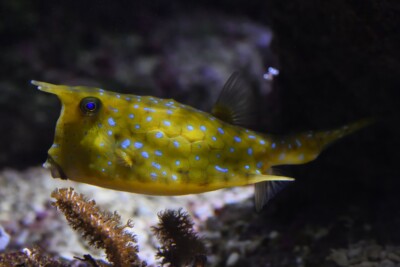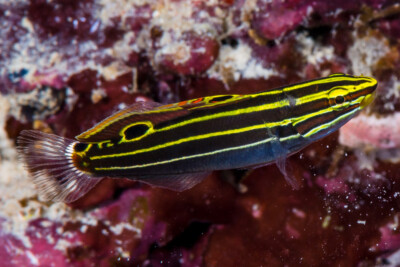false skunk striped anemonefish
| Scientific name | Amphiprion perideraion |
|---|---|
| Descriptor | Bleeker |
| Year of description | 1855 |
| IUCN category (World) | LC |
| Family | Pomacentridae |
| Genus | Amphiprion |


Introduction
Amphiprion perideraion, commonly known as the false skunk striped anemonefish, is a tropical fish native to the Indian and Pacific oceans. It is common in the Indonesian seas and the Great Barrier Reef.
Who is it?
Morphology
-
Type
-
Average size8 cm
-
Maximum size10 cm
-
Longevity15 year
-
ShapeOval
-
Type
-
Average size8 cm
-
Maximum size10 cm
-
Longevity15 year
-
ShapeOval
How to recognize This fish ?
Amphiprion perideraion is easily recognizable by its pinkish color that can range towards orange and its unique white band. It also has a white line connecting the two eyes to the base of the dorsal fin.
Two closely related species do not have the vertical white band on the cheeks: Amphiprion akallopisos (Indian Ocean) and Amphiprion sandaracinos (western Pacific Ocean and eastern Indian Ocean). Amphiprion nigripes (Maldives and Sri Lanka) has a similar pattern, but is red. The belly and the pelvic and anal fins are black.
It also bears resemblance to the Amphiprion leucokranos (Melanesia) but the latter has a widened drop-shaped white band on the cheeks.
Sexual dimorphism
The female is larger than the male. Males may also have a thin orange line on the dorsal fin and tail.
Behaviour & Life cycle
-
dietcarnivorous
-
Sociabilityliving as a couple or in a group
-
territorialYes
-
Way of livingdiurnal
Although slightly territorial, this false skunk striped anemonefish remains a rather peaceful fish that generally behaves peacefully with other species. It even sometimes shares the same anemone with the anemonefish Amphiprion akallopison in the Indian Ocean.
It feeds on plants, vegetation, and micro-organisms closely associated with its host. Usually, they are found in a colony organized around a dominant female. It naturally resides in symbiosis in the anemones Heteractis magnifica. It is sometimes seen in the anemones Heteractis crispa, Macrodactyla doreensis, and Stichodactyla gigantea.
Reproduction
-
Reproductionovipare qui pond sur substrat découvert
-
Hermaphroditeprotandric
This fish is an oviparous species that lays eggs on exposed substrate. The males oxygenate the eggs by stirring them throughout their development. After hatching, the larvae are left to fend for themselves and are carried to pelagic areas by currents. This species reproduces several times a year and each spawning yields between 2,000 and 4,000 eggs.
Harmless species
This species does not represent any particular threats to humans when encountered in its natural environment.
Origin and distribution

What is its habitat?
Natural environment characteristics
-
Temperature22 - 28 °C
-
Depth0 - 0 m
-
FlowMedium and Slow
Biotope presentation
The false skunk striped anemonefish naturally resides in anemones that serve as protection against predators (cf. behavior). It inhabits reefs with a good density of corals at a depth of less than forty meters.
Species of the same biotope
Main recommendations for fishkeeping
Deontology
In order to preserve wildlife, if you acquire this animal, it must not be released into the wild. See also, the Fishipedia charter.
Fishipedia supports the practice of responsible and environmentally friendly aquarium keeping. We encourage maintenance if it is motivated by a desire to understand the biological functioning of living things and if it is done with respect for animal life.
We believe that aquaristics is an opening to the discovery of aquatic environments, especially freshwater, and that this knowledge is necessary to better protect and respect these environments. Logically, we refute the compulsive purchase of animals that would not find a sufficient and / or adapted place in the host aquarium.
Our recommendationsThese tips apply to adult species from breeding. With regards to water conditions, wild species or close relatives must be kept under the same conditions as in their area of origin.
-
Min volume100 liters
-
Population min2
-
Temperature22 - 28 °C
-
pH (acidity)8.2 - 8.4
CharacteristicsThe characteristics below apply for adult species. They correspond to an average of cases, validated in maintenance condition.
-
Difficulty breedingThe farming difficulty is relative. It depends on experiments already carried out with similar species. First, it takes into consideration the robustness of the species, the ease of recreation of a favorable environment and the general behaviour with the other inhabitants of the aquarium.easy
-
Robustnessrobust
-
Behaviourpeaceful
-
Availabilitystandard
General reminders
It is strongly advised to read the complete dedicated file and to get information on the feedbacks of maintenance of the envisaged animal, this to avoid any potential conflict whose end result is generally the death of the individual (or the other inhabitants). It is important not to overload your aquarium to limit pollution. This will make maintenance easier.
General reminder on maintenance datas
Le démarrage d'un aquarium est une partie primordiale pour l'équilibre et le bien-être des poissons. Lorsque l'on met en eau un aquarium, l'eau passe naturellement par un cycle biologique : le cycle de l'azote. Celui-ci dure environ trois semaines. Tous les 2 jours, nous vous conseillons de tester votre eau jusqu'à ce que le taux de nitrite soit à zéro pendant plusieurs jours d'affilée.
Pour accélérer ce cycle, vous pouvez utiliser un activateur de bactéries comme JBL Denitrol. Cette solution riche en bactéries vivantes et enzymes permet une mise en place rapide du cycle de l'azote. Les poissons peuvent alors être introduits plus rapidement.
Il est important de tester l'eau de son aquarium régulièrement pour maintenir un environnement sain pour les poissons et les autres habitants. Les tests d'eau permettent de mesurer les niveaux de différents paramètres tels que le pH, la dureté totale, ainsi que les taux de nitrates, de nitrites et d'ammoniaque.
Pour réaliser ces tests, vous pouvez utiliser des produits d'analyse spécialisés tels que JBL ProScan qui permet de réaliser un diagnostic de l'eau directement via un smartphone. Il existe également des coffrets de tests plus classiques de bandelettes, comme JBL PROAQUATEST.
En cas d’usage de l’eau du robinet, vous pouvez utiliser un conditionneur d’eau de type Biotopol de JBL pour éliminer les substances nocives comme le chlore, le cuivre, le plomb et le zinc. Les conditionneurs d'eau garantissent une meilleure santé aux poissons et une meilleure croissance des plantes.
Chlorine and chloramine are dangerous for the health of animals. Used to disinfect water, these agents are present in significant quantities in tap water. We recommend using an anti-chlorine agent every time you change the water. In addition to chlorine, treatments and medicines sold for aquarium use sometimes contain dangerous heavy metals in high doses.
Specific needs for the false skunk striped anemonefish
The false skunk striped anemonefish is a marine species which lives naturally at a temperature between 22 °C and 28 °C. For proper maintenance, the temperature should never exceed the 31°C for long periods. Nitrate levels should remain below 50mg/L. To keep the water clean and unpolluted, plan on changing 20% to 30% of the water volume each month. In seawater, it is also possible to remove nitrates using one of the following methods: Jaubert, denitrator on sulfur, biopeletts, vodka method.
Breeding this species is accessible to any hobbyist. It is recommended to follow some basic rules and to be rigorous to achieve a good maintenance.
Cohabitation & Environment
In a community aquarium context, this species should be kept in a minimum volume of 100 liters.
Fearful by nature, it is advised not to let the false skunk striped anemonefish cohabit with large territorial species or with too aggressive fish. It can easily evolve with territorial neighbors with a peaceful temperament or with non-territorial species.
Be careful to plan an adequate space for each territorial species. Each species should have a surface and a decor allowing it to juxtapose its territory with that of its neighbors.
The false skunk striped anemonefish is a fish that generally lives in groups outside of the reproduction periods. If you want to reproduce them and have a good chance of forming a couple, it is recommended to keep at least 5 individuals.. In a community aquarium, the chances of survival of the larvae are almost null. After a few spawns, it is preferable to isolate the couple or to separate from the other members of the group.
The hierarchical organization and the aggressiveness between fellow fish can weaken certain individuals, the presence of hiding places becomes then necessary. If you wish to add new members, it is better to introduce younger fish. They will have a better chance of integrating into the new balance.
Tips for feeding
The false skunk striped anemonefish is carnivorous.
This species can eat dry food (flakes, pellets), fresh food and frozen food. To avoid deficiencies, it is recommended to vary the types of food.
You should not overfeed your residents to avoid polluting the water. For most species, it is better to feed a few small portions each day rather than one large meal.
Reproduction protocol
-
Maintenance difficultymoderate
-
Spawning cleaningFemale & Male
-
egg-laying protectionFemale & Male
-
Fry protection
Hybridization risks
In general, it is advised not to mix several species of the same genus or different varieties of the same species, to avoid the risks of hybridization.
These animals might interest you
To go further
Sources & Contributions
Participation & Validation
The Fishipedia team and specialist contributors are committed to providing high-quality content. However, although the information comes from scientific sources or testimonials from specialists, the cards may contain inaccuracies.

Benoit Chartrer

Marc Raggi
Translation
Translation done with the valuable contribution of our translators, who make this information available to a wider audience. We sincerely thank them for their commitment.
Bibliographic references
FIELD GUIDE TO ANEMONE FISHES AND THEIR HOST SEA ANEMONES - Dr. Daphne G. Fautin - GERALD R. ALLEN - Western Australian Museum - 1992.
POMACENTRIDAE - GERALD R. ALLEN - FAO Fisheries Synopsis - 2001. ISBN 92-5-104587-9
Scientific partners
Tags
Species of the same family
Same genus
Species of the same biotope







































